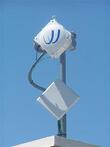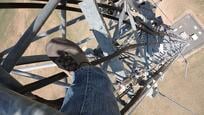Point to point wireless Ethernet bridges, also known as fixed wireless backhaul, are becoming extremely popular among organizations across all vertical markets. Once used only by the large telecommunication companies, wireless Ethernet bridges are being implemented by everyone, from federal, state, county, and local governments, utilities, health care organizations, agricultural industries, and even the private commercial sectors.
 Wireless backhaul is an ideal complement or complete replacement to leased lines and fiber. Whether the requirement is to link the data and voice networks between individual buildings or link networks across large distances, organizations are increasingly turning to point to point wireless networks, both licensed microwave links and unlicensed wireless backhaul, as the preferred solution. Point to point wireless backhaul provides several advantages over leased lines:
Wireless backhaul is an ideal complement or complete replacement to leased lines and fiber. Whether the requirement is to link the data and voice networks between individual buildings or link networks across large distances, organizations are increasingly turning to point to point wireless networks, both licensed microwave links and unlicensed wireless backhaul, as the preferred solution. Point to point wireless backhaul provides several advantages over leased lines:
- Increased Bandwidth - With all the applications that are now driven across the network, IT departments are requiring more bandwidth across their network infrastructure. An outdoor wireless Ethernet bridge can provide true Ethernet throughput up to GigE Full Duplex (using gigabit wireless links).
- Lower cost of installation and no recurring costs - Probably the number one driver for turning to outdoor wireless backhaul is the tremendous ROI point to point wireless bridges provide. On a 100Mbps Full Duplex wireless backhaul link the typical ROI is about 3 months. This is compared to a leased DS3 at 45Mbps. So you can get over double the throughput and eliminate any reoccuring operational costs almost immediately. The wireless cost reduction savings can be even greater when compared o the cost of installing fiber networks.
- Last mile connections - In many cases, organizations such as government or utilities who maintain multiple sites, just can't get their required bandwidth out to remote locations. Sometimes the best a local telco can provide is a T1. Point to point wireless can reach up to 50+ miles (if designed and installed properly). Where once you could only get a T1 circuit, you can now get 100Mbps Full Duplex up to GigE (gigabit wireless) throughput, better known as wireless last mile.
- Quick installation- A typical point to point wireless backhaul can be installed in a couple days. I always recommend using industry professionals that have a lot of experience (see my article "Wireless Installtion Done Properly").We've talked to a lot of clients that have waited over 6 months to have their telco provision a simple circuit. This is especially true when compared to fiber installations that can takes years to gain right away access and time it takes to trench conduit paths.
- Reliability - Wireless backhauls designed and installed properly can provide 99.999% predictable reliability (see my article "Is Wireless Reliable"). Most telco's only provide a SLA of 99.9% uptime. In many cases where a client has installed wireless backhaul, like licensed microwave or millimeter wave gigabit wireless, for fiber redundancy we have seen the client actually convert over to using the wireless point to point backhaul as their primary and down grade their fiber connection as their redundancy. This is because the wireless backhaul typically provides a more direct path (less routing in the case of leased circuits) and is cheaper to maintain.
Point to point wireless Ethernet bridges can be used by any organization that has more than one facility that they need to connect to. There is a multitude of products in the market, both licensed microwave links and unlicensed wireless Ethernet bridges, that can solve many connectivity issues. Th price of wireless backhaul has come way down in price and is more affordable than ever. The quality of outdoor wireless backhaul is better than most other methods of connectivity.
The main reason more organizations haven't turned to outdoor wireless backhaul is either it is just not feasible do to their locations or a lack of education on what can be done with today's technology. The first step is to get a Feasibility Study by a qualified outdoor wireless vendor. A good wireless integrator can outline the best solution and the cost benefits.





